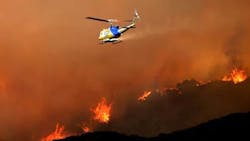CA Chopper Pilots Face High Winds for Wildfire Air Drops
It's a familiar scene: A fire erupts, firefighters battle the flames from the ground and water is sprayed across the land from the sky. The aerial fight occurs often, even when winds are strong, raising the question of how effective airborne firefighting tactics are when wind conditions are dangerous.
On Wednesday, as the Easy fire ravaged more than 1,300 acres in Simi Valley, the winds hit 60 mph. Overhead, helicopters were seen dousing the fire below, and two "super scooper" planes unleashed a flood in Ventura County.
RELATED:
- Strong Winds Fuel Wildfire Outbreak Across CA
- CA Crews Find Ways to Battle Wildfires Without Power
- CA Wildfire Burning Out of Control
- Fierce Winds Driving Massive CA Wildfire
- Two Firefighters Burned Fighting CA Wildfire
- CA Governor: FFs Called to 330 Wildfires in 24 Hours
- Watch CA Firefighters' Terrifying Drive Through Wildfire
- How CA Firefighters Saved Reagan Library from Wildfire
"Water remains our No. 1 firefighting tool," said Jim Hudson, an assistant chief at the California Department of Forestry and Fire Protection. And typically, every available resource is utilized.
The sight of a water drop can often offer hope to those below. But effectiveness is not always easy to measure, especially when resource costs are taken into account.
Most firefighting aircraft in the U.S. are owned or operated by private companies under government contract. It typically costs up to $14,000 a day to keep an air tanker on call. Heavy-duty helicopters can cost $32,000 a day on standby, plus $6,300 per hour of flight time.
Hudson said that during high winds, a helicopter would typically be opted for deployment over a larger air tanker, as the smaller aircraft can more effectively operate at lower elevations to target the fire.
"They have a higher probability of dropping water on targets," Hudson said.
But that doesn't mean a 100% guarantee. Firefighting aircraft come with limitations, often magnified when battling choppy skies.
So why use water drops when wind is a constant obstacle?
For one thing, the equipment can hold hundreds upon hundreds of gallons of water, Hudson said. Additionally, a nearby pond or lake can offer a refill supply, offering a large volume of water without diverting time to the search for resources.
Hudson said that the effectiveness of this approach is an ongoing assessment. Typically, it's up to the individual agency that oversees the air supply to decide what equipment to deploy.
"Every agency is going to work in conjunction with the incident commander on the ground," Hudson said.
———
©2019 the Los Angeles Times
Visit the Los Angeles Times at www.latimes.com
Distributed by Tribune Content Agency, LLC.
